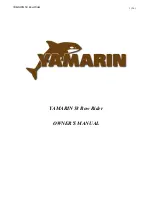
23
19 SPX
19 SPX e
lectrIcal
S
yStem
1. Dc s
YsTeM
The 12 volt direct current (DC) electrical system
(similar to that in your car or truck) derives its power
from the batteries. Batteries are kept charged by
the engine-driven alternator or the optional battery
charger/converter which must be powered by shore
power. The batteries supply power to the fuses in
the engine compartment, or the circuit breakers on
the main DC breaker panel. This panel contains the
breakers which supply power to the subpanels and
fuse blocks at the control station.
The negative terminal of each bank of batteries
is attached to the negative ground studs of
the propulsion engines. This “negative ground
system” is the approved system for marine DC
electrical systems.
Ask your dealer for a careful analysis of DC power
needs on your boat. It may be necessary to add
batteries or auxiliary charging methods to supply
adequate power for any additional accessories you
wish to install.
DO NOT USE JUMPER CABLES IN THE ENGINE
COMPARTMENT.
They can cause an explosion from sparks.
!
DANGER
A battery will explode if a flame or spark ignites
the free hydrogen given off during charging.
Never use an open flame or strike sparks in the
battery area.
!
DANGER
2. b
aTTeries
The batteries installed in your boat have been
selected for their ability to furnish starting power
based on engine starting requirements, as well as
their ability to power the DC accessories attached
to the electrical system.
The following tables describe the recommended
marine batteries to install in your boat. All batteries
in a battery bank should be of the same type, age,
and rating.
Standard:
Application
Volts
CCA
RC
QTY
1
st
Battery
12
800
180
1
2
nd
Battery (opt)
12
800
180
1
The battery trays and battery cabling installed at
the manufacturing facility will indicate the quantity
of the batteries needed in your boat. Installing the
minimum size battery listed above will insure that
the battery bank will be sized appropriately.
COLD CRANKING AMPS (CCA) - a rating used
in the battery industry to classify a battery's ability
to start an engine in cold temperatures. The rating
is the number of amps a fully charged battery can
deliver at 0º Fahrenheit for 30 seconds, while
maintaining a voltage of at least 7.2 volts, for a 12
volt battery.
RESERVE CAPACITY (RC) - is a battery industry
rating, defining a battery's ability to power a vessel
without a charging device to replenish the battery.
The rating is the number of minutes a battery at
80º Fahrenheit can be discharged at 25 amps and
maintain a voltage of 10.5 volts for a 12 volt battery.
BATTERY BANK - one or more batteries connected
together in series or parallel to provide the sufficient
Cold Cranking Amps or Reserve Capacity needed
to meet engine and calculated boat loads.
To prevent arcing or damage to the alternator,
always disconnect battery cables before doing any
work on the engine’s electrical system.
!
CAUTION
19 SPX_Book 1.indb 23
9/4/2014 2:12:30 PM
Summary of Contents for 19 SPX
Page 1: ...Manual Part Number MRP 2150996 19 SPX Owner s Manual 19 SPX_Book 1 indb 3 9 4 2014 2 12 12 PM...
Page 2: ...19 SPX_Book 1 indb 4 9 4 2014 2 12 13 PM...
Page 6: ...19 SPX_Book 1 indb 4 9 4 2014 2 12 14 PM...
Page 48: ...19 SPX_Book 1 indb 2 9 4 2014 2 12 39 PM...
Page 49: ...19 SPX_Book 1 indb 3 9 4 2014 2 12 39 PM...
Page 50: ...www searay com 19 SPX_Book 1 indb 4 9 4 2014 2 12 39 PM...
















































